
Alphabet H ©

In the classical Judgment Scene, Assur renders judgment of all under heaven.
There are many versions of the Judgment Scene. The Judgment Scene was a part of every official "burial" in Egypt from the beginning to the end. (Common folks and ordinary soldiers didn't get official "burials.") Many beautifully illustrated versions of the Judgment Scene have come down to us from the tombs of royal persons and powerful citizens. In the classical Judgment Scene, Assur's throne rests under a canopy. The details vary from one version to another, but there is always a canopy. That canopy represents the vault of heaven supported by the four winds.
The (majuscule) capital letter H depicts the vault-of-heaven canopy over the Judgment Scene.
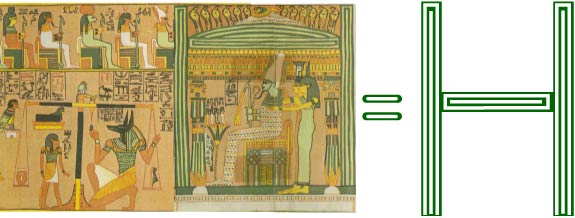
The above version of the Judgment Scene is from the Egyptian Book of the Dead. The image above Assur's throne is a stylized version of the winged sun-disk, uraeus.
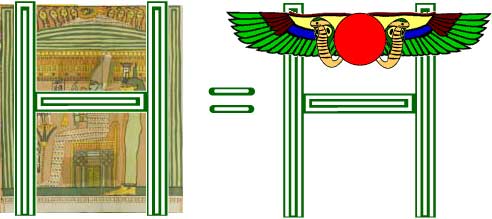
The minuscule letter h is a picture of a hut.
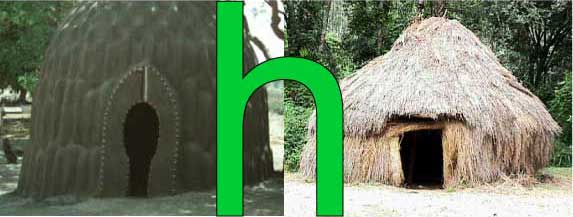
The majuscule letters are heaven symbols. The minuscule letters are earth symbols. The majuscule letter H represents the vault of heaven supported by the four winds. The minuscule letter h represents an earthly human habitation. Minuscule letter h pictures a common hut with a plume of smoke rising from the smoke hole. The sound of H is derived from the sigh of the wind.
ADDENDUM #1
About the Uraeus symbol:
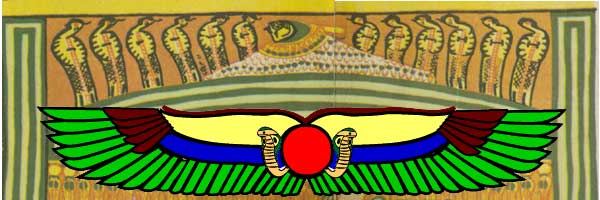
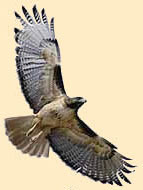 The desire to fly resides deep in humankind. Our space program is a manifestation of that desire. Before the meltdown of the Ice Age, our hunter/gatherer ancestors revered hawks. They desired the hawk's power to soar over the brambles, gullies, hills, and streams of the hunter's terrestrial terrain. The vision of a hawk swooping down and taking its prey on the fly lent powerful imagery to their primitive hunting religions, and to their languages.
The desire to fly resides deep in humankind. Our space program is a manifestation of that desire. Before the meltdown of the Ice Age, our hunter/gatherer ancestors revered hawks. They desired the hawk's power to soar over the brambles, gullies, hills, and streams of the hunter's terrestrial terrain. The vision of a hawk swooping down and taking its prey on the fly lent powerful imagery to their primitive hunting religions, and to their languages.
Before the melt down of the Ice Age, humankind lived for millions of years by some form of hunting and gathering economy. When the Ice Age melted down, our ancestors' hunting and gathering economy collapsed. When their hunting and gathering economy collapsed, they became farmers and herders instead of hunters and gatherers.
Once they became farmers, they recognized the sun as the source of their sustenance. They became sun worshippers. Becoming farmers didn't diminish their desire to fly. Perhaps the toil and drudgery of agricultural labor increased their desire to fly. Hawk imagery continued to be a part of their culture, religion, and language.
 The UrRe sunwing is a compound symbol from old hawk-god religion and new sun-god religion. The name UrRe is a compound name composed of Ur, the hawk-god plus Re, the sun-god.
The UrRe sunwing is a compound symbol from old hawk-god religion and new sun-god religion. The name UrRe is a compound name composed of Ur, the hawk-god plus Re, the sun-god.
Isis was the "serpent goddess." She was "twice wise." The sacred asp of Isis was the Pagan symbol of "double wisdom." Before the birth of Isis, the UrRe sunwing without serpents was the identifying mark of the UrRean religion in the ancient UrRean kingdoms of Assur's descendants. After the Genesis of Isis, her bloodline became the royal bloodline in the old UrRean kingdoms.
 Assur's descendants added the twin asps of Isis to their UrRe sunwing to create the Uraeus sunwing. The name Uraeus is a compound name composed of Ur, the hawk-god, plus Re, the sun-god, with the hiss of the asp added to it.
Assur's descendants added the twin asps of Isis to their UrRe sunwing to create the Uraeus sunwing. The name Uraeus is a compound name composed of Ur, the hawk-god, plus Re, the sun-god, with the hiss of the asp added to it.
ADDENDUM #2 04/12/2003
About the name Heru:
Thoth was the "scribe of the gods." Thoth was the patron god of scribes. Scribes of the Thoth school were more than simple scribes. They were philosophers, mathematicians, astronomers, architects, and architects of languages. Scribes of the Thoth school created many words and names. They used the names of gods and the functions of gods to create words and give them meanings.
Heru was one of the earliest gods of the Pagan pantheon. Hawk worship of some kind surely preceded the Pagan religion of the Isis bloodline. The ur sound of hawk's wings and the name Heru form the basis of many Thothian formulated words and names. (See the Sunwing page on this website about the hawk god's name.)
The name Heru comes down to us from translations of Egyptian hieroglyphics with the hard H(wind, breath) sound included as part of the name. However, that hard H(wind, breath) sound in the name Heru is often missing in Thothian linguistics. There are many words and names based on a silent H ('Eru) form of the hawk god's name without the hard H sound.
The words hero, hieroglyph, hair, horse, and the Greek name Horus all contain the hard H sound from the name of Heru along with some form of hawk god imagery. The words arrow, air, heir, hour, aura, oro, and many others are based on the 'Eru, silent H form of the name. The Ir- in the names Iran, Iraq, and Ireland is from the 'Eru, silent H, form of the hawk god's name. UrRean(Iran), UrRequa(Iraq), and UrReland(Ireland), along with UrReope(Europe) are all based on the silent H form of hawk god's name. In all, there appears to be more words and names based on the silent H ('Eru) form of the hawk god's name than there are based on the hard H (Heru) form of the hawk god's name.
This is visual language. Visual language is language based on sound AND imagery. Human civilization needs a universal language. No system of arbitrary sounds without imagery could function as a universal language. Visual language has the power to be universal language.
Resurrect Isis. Her language is universal language. Her message is universal love.
|
Reader responses are invited. |
Return to Home Page . . . Return to Table of Contents Hub
Links to alphabet pages:
Link to Alphabet Page G . . . Link to Alphabet Page I
Links to related topic pages:
Visual Language . . . Sunwing . . . Alphabet Page R . . . Alphabet Page S